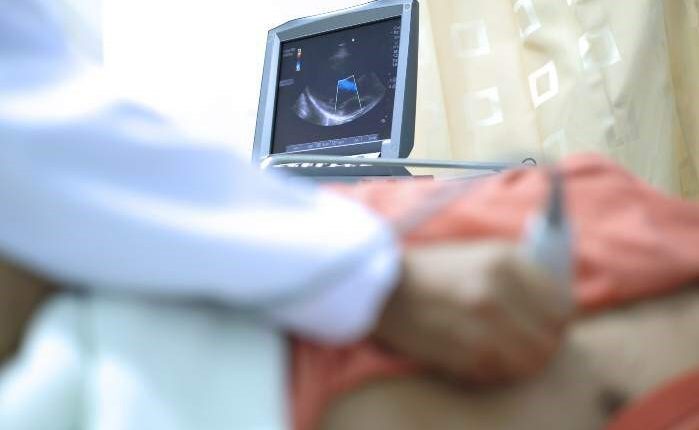
What is transthoracic echocardiography?
Echocardiography (or echocardiogram) is a method by which the heart and blood flow through the valves are studied using ultrasound
Unlike the radiation used in radiology, ultrasound is harmless, so no precautions are necessary and the test can be performed on any patient countless times (even in pregnant women).
What is transthoracic echocardiography used for?
Transthoracic echocardiography provides detailed information on the size and function of the heart and valve apparatus.
Who can perform transthoracic echocardiography?
There are no particular contraindications to echocardiography: anyone can undergo the test.
How does transthoracic echocardiography work?
The patient must lie bare-chested on the sonographer’s couch, who will place electrodes on his chest.
Next, the sonographer will spread a special gel on the patient’s chest and on the transducer, a probe which, when placed on the chest, emits ultrasound which, reflected and processed by the equipment, makes it possible to visualise the heart and its structures.
The probe is moved over the chest with gentle pressure.
The patient may be asked to remain still or breathe deeply.
At the end of the test, the electrodes will be removed and all that remains is to wipe off the gel left on the chest. The total duration of the test is approximately 10-15 minutes.
Is transthoracic echocardiography a painful or dangerous test?
Transthoracic echocardiography is neither invasive nor painful and allows you to resume your normal routine immediately after the test.
Even when it involves the use of contrast agents, these are non-ionising substances that are harmless to health.
Read Also
Emergency Live Even More…Live: Download The New Free App Of Your Newspaper For IOS And Android
Electrocardiogram (ECG): What It Is For, When It Is Needed
What Are The Risks Of WPW (Wolff-Parkinson-White) Syndrome
Heart Failure: Symptoms And Possible Treatments
What Is Heart Failure And How Can It Be Recognised?
Inflammations Of The Heart: Myocarditis, Infective Endocarditis And Pericarditis
Quickly Finding – And Treating – The Cause Of A Stroke May Prevent More: New Guidelines
Atrial Fibrillation: Symptoms To Watch Out For
Wolff-Parkinson-White Syndrome: What It Is And How To Treat It
Do You Have Episodes Of Sudden Tachycardia? You May Suffer From Wolff-Parkinson-White Syndrome (WPW)
What Is Takotsubo Cardiomyopathy (Broken Heart Syndrome)?
Heart Disease: What Is Cardiomyopathy?
Inflammations Of The Heart: Myocarditis, Infective Endocarditis And Pericarditis
Heart Murmurs: What It Is And When To Be Concerned
Broken Heart Syndrome Is On The Rise: We Know Takotsubo Cardiomyopathy
Heart Attack, Some Information For Citizens: What Is The Difference With Cardiac Arrest?
Heart Attack, Prediction And Prevention Thanks To Retinal Vessels And Artificial Intelligence
Full Dynamic Electrocardiogram According To Holter: What Is It?
In-Depth Analysis Of The Heart: Cardiac Magnetic Resonance Imaging (CARDIO – MRI)
Palpitations: What They Are, What Are The Symptoms And What Pathologies They Can Indicate
Cardiac Asthma: What It Is And What It Is A Symptom Of
Cardiac Rhythm Restoration Procedures: Electrical Cardioversion
Abnormal Electrical Activity Of The Heart: Ventricular Fibrillation
Gastro-Cardiac Syndrome (Or Roemheld Syndrome): Symptoms, Diagnosis And Treatment
Cardiac Arrhythmias: Atrial Fibrillation
Interventricular Septal Defect: What It Is, Causes, Symptoms, Diagnosis, And Treatment
Carotid Stenosis: What Is It And What Are The Symptoms?
Supraventricular Tachycardia: Definition, Diagnosis, Treatment, And Prognosis
Ventricular Aneurysm: How To Recognise It?
Atrial Fibrillation: Classification, Symptoms, Causes And Treatment
EMS: Pediatric SVT (Supraventricular Tachycardia) Vs Sinus Tachycardia
Atrioventricular (AV) Block: The Different Types And Patient Management
Pathologies Of The Left Ventricle: Dilated Cardiomyopathy
A Successful CPR Saves On A Patient With Refractory Ventricular Fibrillation
Atrial Fibrillation: Symptoms To Watch Out For
Atrial Fibrillation: Causes, Symptoms And Treatment
Difference Between Spontaneous, Electrical And Pharmacological Cardioversion
‘D’ For Deads, ‘C’ For Cardioversion! – Defibrillation And Fibrillation In Paediatric Patients
Inflammations Of The Heart: What Are The Causes Of Pericarditis?
Do You Have Episodes Of Sudden Tachycardia? You May Suffer From Wolff-Parkinson-White Syndrome (WPW)
Knowing Thrombosis To Intervene On The Blood Clot
Patient Procedures: What Is External Electrical Cardioversion?
Increasing The Workforce Of EMS, Training Laypeople In Using AED
Heart Attack: Characteristics, Causes And Treatment Of Myocardial Infarction
Altered Heart Rate: Palpitations
Heart: What Is A Heart Attack And How Do We Intervene?
Do You Have Heart Palpitations? Here Is What They Are And What They Indicate
Palpitations: What Causes Them And What To Do
Cardiac Arrest: What It Is, What The Symptoms Are And How To Intervene
Diseases Of The Valves Of The Heart: Aortic Stenosis



